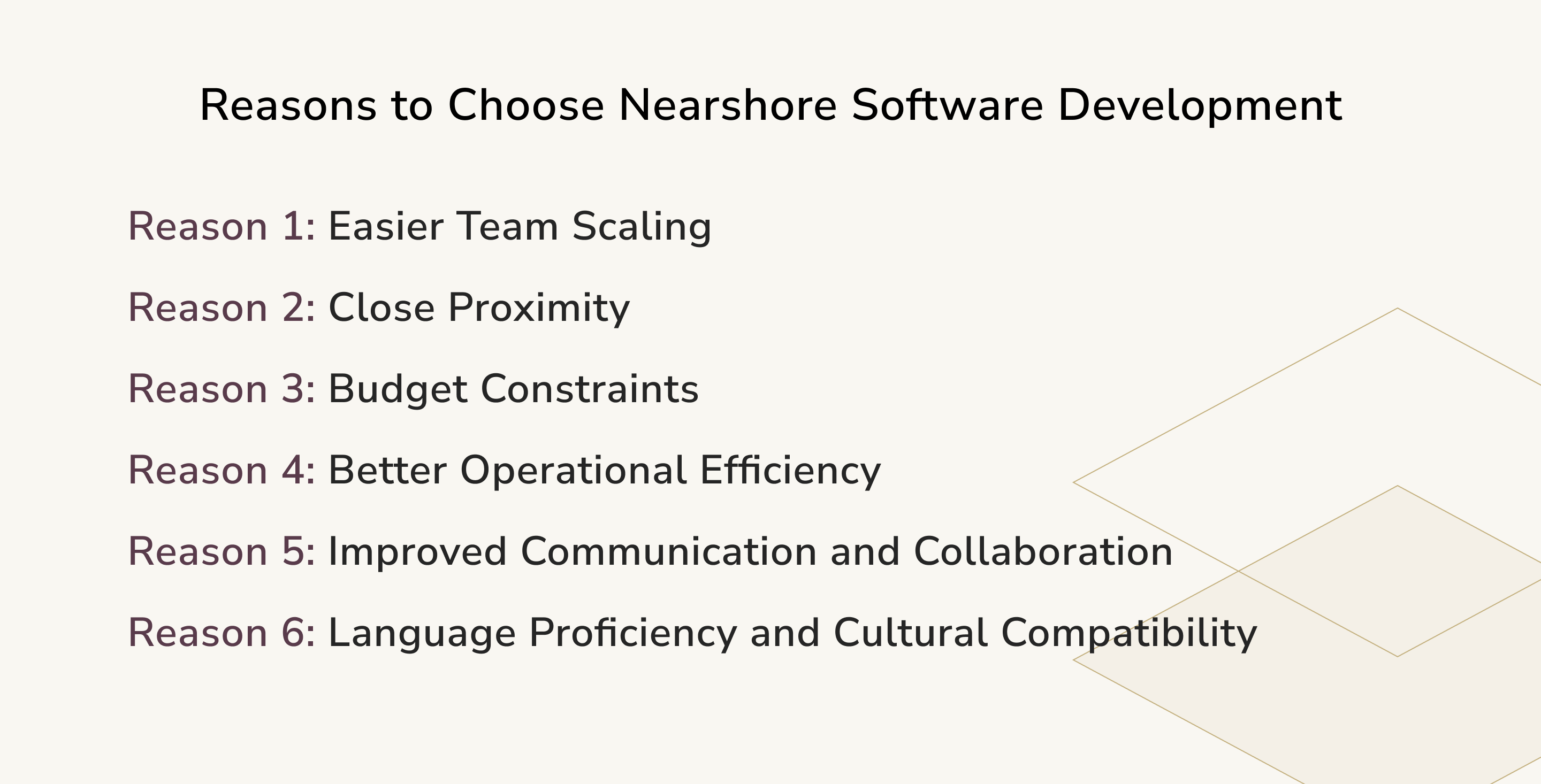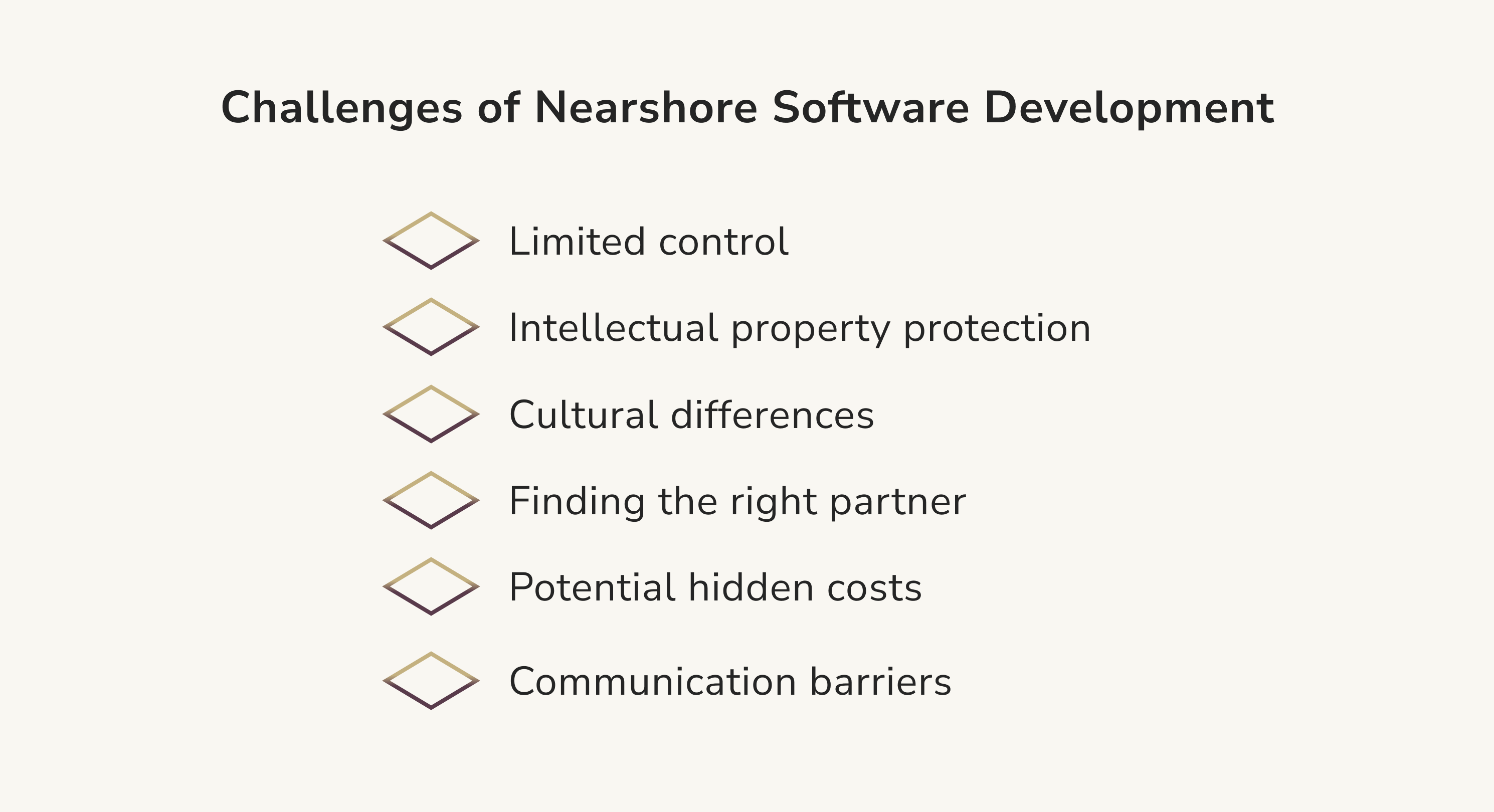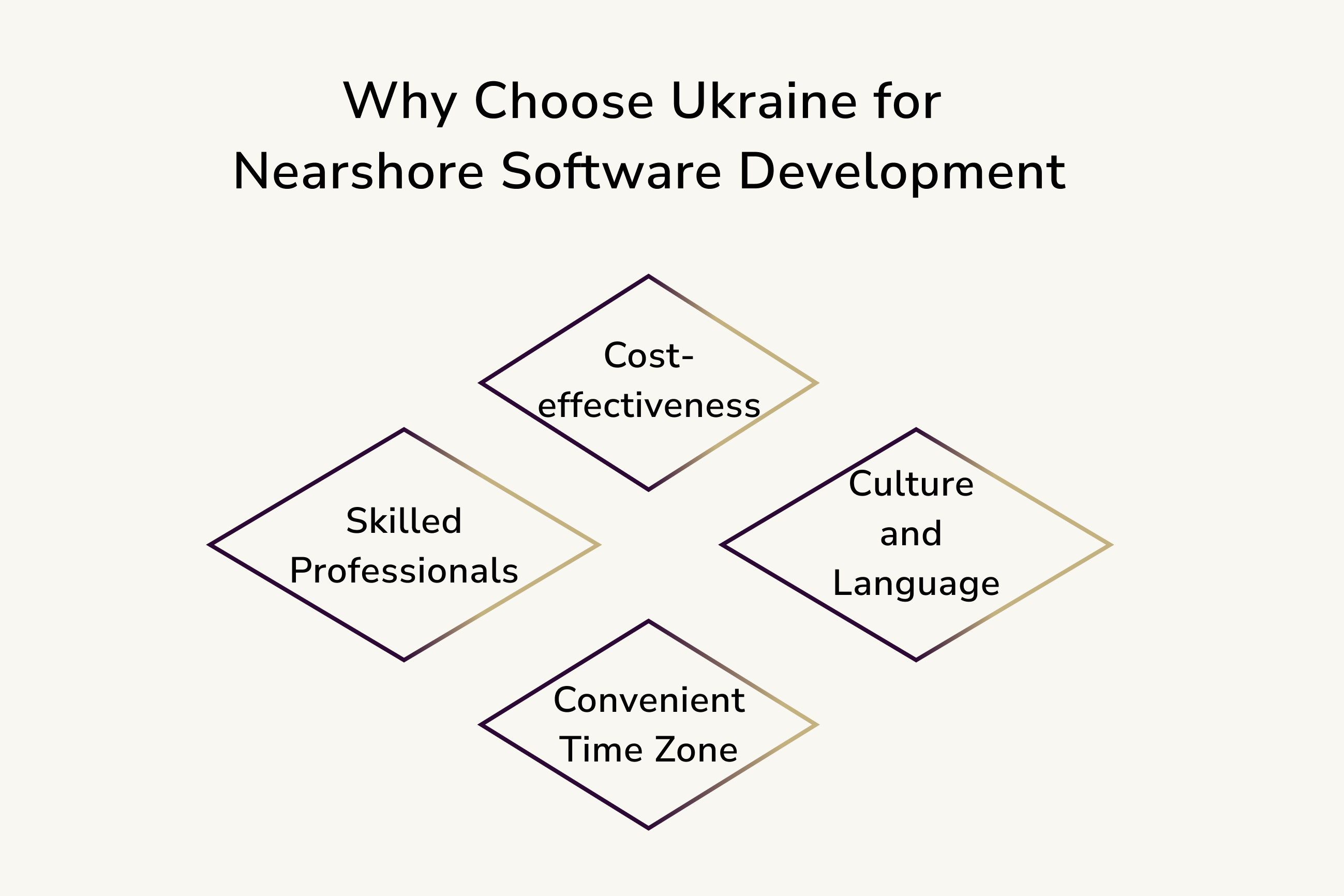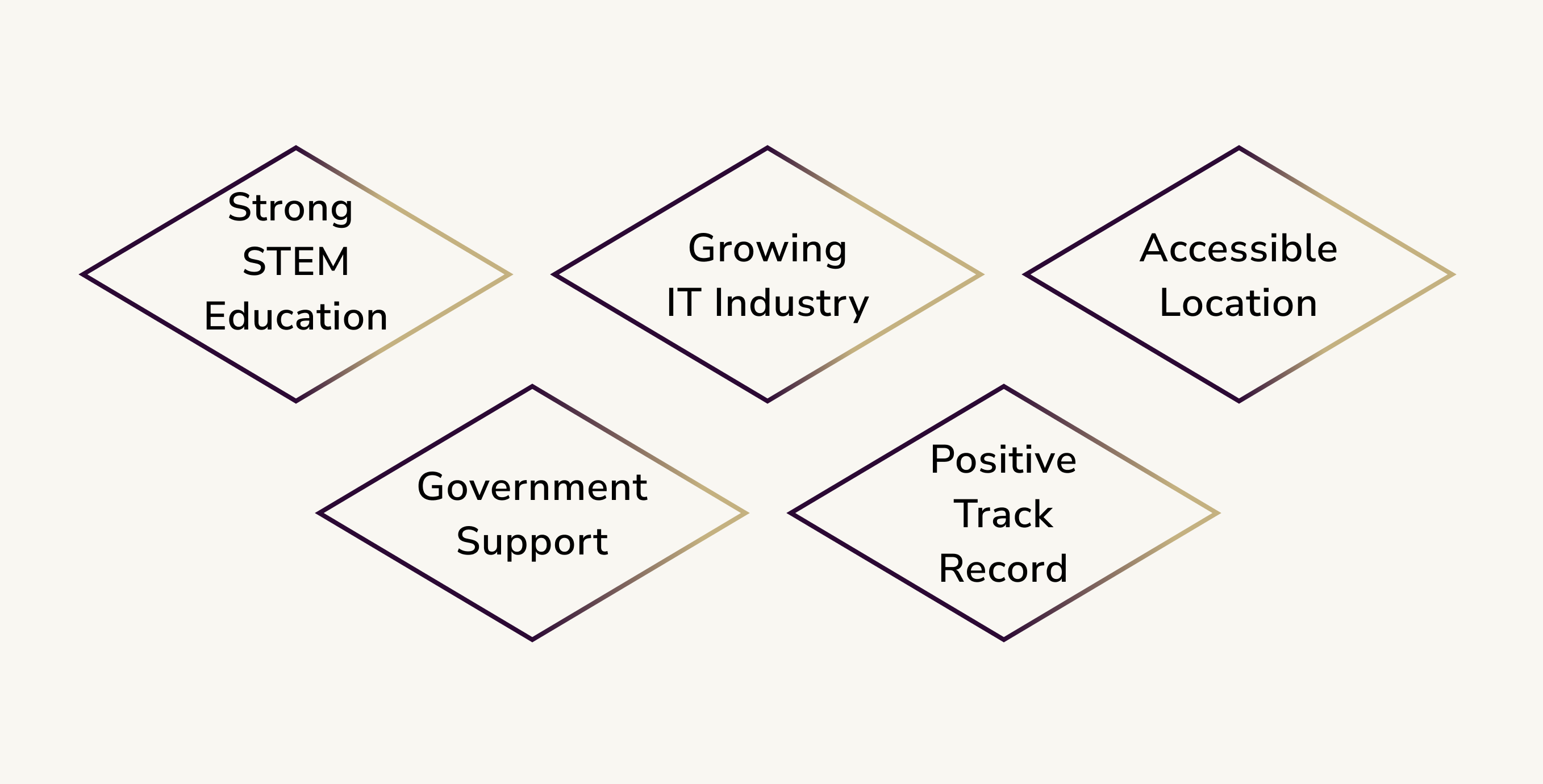A Brief Guide to Nearshore Software Development

According to Statista, the global outsourcing market is currently valued at $430 billion and is expected to reach $587 billion by 2027. Besides, there are about 27 million software developers on hire globally. In such a context, with the phenomenon rising in popularity, a growing number of businesses are looking to use different types of outsourcing, including nearshoring.
Nearshore software development refers to outsourcing software development tasks to neighboring countries or countries within proximity, sharing similar time zones and cultural backgrounds.
This topic is important as it offers cost-effective solutions, improved communication, and easier collaboration due to minimal time differences and cultural similarities, ultimately leading to higher-quality software products.
Those interested in this article include businesses seeking to outsource software development, IT professionals exploring outsourcing options, and countries aiming to establish themselves as nearshore development hubs.
What is Nearshore Software Development?
Nearshore software development outsourcing is a practice where IT companies delegate their software development tasks to neighboring countries or countries within proximity, sharing similar time zones and cultural backgrounds. This approach facilitates better communication, collaboration, and cost-effectiveness compared to distant outsourcing options.
Clients from Europe, mainly the United Kingdom and Germany, often seek nearshore outsourcing solutions to leverage the benefits of geographical proximity and lower costs. Eastern Europe is a top outsourcing destination for these clients due to its competitive pricing, strong IT industry, and skilled workforce. Countries such as Poland, Romania, and Ukraine offer high-quality software development services, making them attractive nearshore partners for European businesses seeking cost-effective solutions without compromising quality.
Nearshore software development outsourcing has become a go-to strategy for businesses looking to balance cost, quality, and efficient communication. Here are more details and examples of nearshore software development:
- Poland. Poland has become a preferred nearshore destination for many European countries because it has a strong educational system and a growing IT sector. The country offers a skilled talent pool, competitive rates, and a high level of English proficiency. Companies such as Ciklum and STX Next have established themselves as leading Polish software development providers.
- Romania. Romania has emerged as an attractive nearshore development destination known for its highly skilled workforce and proficiency in multiple programming languages. Companies like Pentalog and Fortech offer a wide range of IT services, from software development to testing and support.
- Ukraine. Due to our country's vibrant tech life, IT outsourcing to Ukraine has become a popular practice for European leaders. Ukraine has many skilled IT professionals, providing a cost-effective, quality-driven workforce. Most notable companies offer top-notch software development, testing, and consulting services.
- Hungary. This outsourcing destination has positioned itself as a competitive nearshore software development hub, benefiting from a highly educated workforce and affordable rates. Leading companies such as EPAM Systems and Tresorit have established a presence in the country, offering services such as custom software development, cloud computing, and security solutions.

How Nearshore Software Development Functions
Nearshore software development functions through a process that involves collaboration between clients and service providers located in neighboring countries or within proximity. The key aspects of how nearshore software development functions include:
- Identifying requirements. The client outlines their software development needs, defining project scope, objectives, budget, and timeline. Based on this data, the provider can then offer a choice between suitable nearshore models.
- Select a partner. Clients research and evaluate potential nearshore partners based on expertise, experience, reputation, cost, and cultural compatibility. This process may involve issuing a Request for Proposal (RFP) or engaging in direct negotiations.
- Establishing communication. Effective communication is crucial in nearshore software development. Clients and providers establish communication channels and protocols, including project management tools, video conferencing, and instant messaging.
- Forming a team. The nearshore offshore outsourcing provider assembles a team of skilled professionals tailored to the client's requirements, such as project managers, developers, designers, and quality assurance specialists.
- Project planning. The nearshore team collaborates with the client to develop a project plan detailing tasks, milestones, and deadlines. This plan helps both parties track progress and ensure timely delivery.
- Development and collaboration. The nearshore team works on the project, maintaining regular communication with the client through scheduled meetings, progress reports, and ad hoc updates. Clients may also have representatives or key stakeholders working closely with the nearshore team.
- Quality assurance and testing. Nearshore providers conduct thorough testing and quality assurance to ensure the developed software meets the client's specifications and standards.
- Delivery and deployment. Once the software is tested and approved, the nearshore team delivers the final product to the client, who then deploys it within their organization.
- Ongoing support and maintenance. Many nearshore providers offer ongoing support and maintenance services, ensuring the software functions optimally and addressing any issues that may arise.
The nearshore software development process leverages the advantages of geographical proximity, time zone alignment, and cultural similarities to facilitate smooth collaboration and high-quality results. Yet, there are some reasons to consider when considering nearshore software development.
Reasons to Choose Nearshore Software Development
Nearshore software development is not an easy task to pull off. You must have particular reasons to engage in the process in such a case. Those reasons should carry some weight. At this point, these are the reasons to choose nearshore software development:
Easier Team Scaling
Nearshore providers enable more manageable team augmentation for multinational companies with dynamic project requirements. For example, a company working with a nearshore partner in Poland may start with a small team of developers for an initial project phase.
As the project scope expands, the company can quickly onboard additional developers or specialists, like UI/UX design professionals, to address the growing demands. This flexibility allows for better resource allocation, minimizing underutilization and overloading of team members.
Close Proximity
The geographical proximity of nearshore partners offers several benefits. For instance, a UK-based company working with a software development team in Eastern Europe can easily arrange face-to-face or on-site visits, fostering stronger relationships and collaboration. Similarly, close time zones between the two countries enable real-time communication, allowing teams to address questions, feedback, or issues without waiting for responses due to time differences.
Budget Constraints
Nearshore software development outsourcing can provide significant cost savings for businesses. For example, a German company opting to outsource software development to Ukraine may find that the costs of employing skilled developers are substantially lower than hiring local talent. This cost efficiency enables businesses to allocate resources more efficiently, getting more value for their investment without sacrificing the quality of the digital product.

Better Operational Efficiency
The nearshore development team can improve operational efficiency through smoother communication and collaboration. For example, a UK-based company working with a nearshore partner in Ukraine can benefit from cultural similarities and shared business practices, making project coordination more seamless. This familiarity helps reduce misunderstandings, promote faster decision-making, and streamline project execution, leading to a more efficient development process.
Improved Communication and Collaboration
Geographical proximity and cultural similarities contribute to smoother communication and collaboration between nearshore teams and clients. This helps to prevent misunderstandings, improve project coordination, and promote a more effective development process.
Language Proficiency and Cultural Compatibility
Many nearshore countries have a high level of English proficiency, ensuring minimal language barriers. Additionally, the shared cultural background between nearshore countries and their clients facilitates a better understanding of each other's work habits and expectations, leading to a more harmonious working relationship.
These reasons make nearshore software development an attractive option for businesses seeking to optimize resources, improve collaboration, and achieve cost-effective development outcomes.
Advantages of Nearshore Software Development
Nearshore software development offers a range of advantages for businesses seeking to outsource their software development tasks:
Cost-Effectiveness
According to McKinsey, the labor cost in Eastern European countries can be up to 60% lower compared to Western Europe. Nearshore software development offers a cost-effective solution by allowing businesses to access high-quality services at a lower price point.
For example, outsourcing to Eastern European countries, like Poland or Romania, can yield substantial cost savings due to lower labor costs than Western Europe or North America. This cost advantage enables companies to allocate resources more efficiently, achieving more value for their investment without compromising quality.
Huge Talent Pools
There are an estimated 1 million developers in Eastern Europe. In this case, nearshore destinations often possess a wealth of skilled IT professionals with diverse expertise in various technologies, frameworks, and programming languages. For instance, countries like Ukraine strongly focus on IT education, resulting in a continuous influx of talented nearshore developers entering the workforce. This ensures businesses can access various skill sets necessary to deliver successful software projects.
Fewer Problems with Documents and Legal Regulations
Working with nearshore partners can ease the legal and regulatory aspects of outsourcing. Neighboring countries often share similar legal frameworks and have established trade agreements, reducing bureaucratic obstacles and making it easier to create contractual relationships. For example, European Union (EU) member states benefit from standardized regulations and seamless cross-border transactions, simplifying the outsourcing process for businesses within the EU.
Minor Time Zone Differences
Time zone alignment is a significant advantage of nearshore software development, as it allows for real-time communication and collaboration between teams. For instance, a German company working with a development team in Ukraine will experience minimal time zone differences, enabling both teams to work simultaneously and promptly address questions, feedback, or issues without waiting for responses due to time differences.
Better Communication and Collaboration
Geographical proximity and cultural similarities contribute to more effective communication and collaboration in nearshore software development. For example, a UK-based company working with a nearshore partner in Ireland would benefit from shared cultural norms and business practices, making project coordination more seamless. This familiarity helps reduce misunderstandings, promotes faster decision-making, and streamlines project execution, leading to a more efficient development process.
Good English Language Proficiency and Cultural Match
Many nearshore countries have a high level of English proficiency, ensuring minimal language barriers. For instance, countries like Poland and Romania prioritize English language education, resulting in a workforce that can communicate effectively in English. According to EF English Proficiency Index, Poland, Hungary, and Ukraine are among the countries with great English proficiency.
Additionally, the shared cultural background between nearshore countries and their clients facilitates a better understanding of each other's work habits and expectations, leading to a more harmonious working relationship between internal teams and outsourced developers.
Challenges of Nearshore Software Development
While nearshore software development offers numerous benefits, it also presents certain challenges that businesses must consider before opting for this outsourcing model:
- Limited control. Outsourcing to nearshore partners means businesses may have limited control over the development process compared to in-house teams. This could make monitoring progress, ensuring quality, or enforcing deadlines difficult.
- Intellectual property protection. When outsourcing software development to nearshore partners, businesses must take measures to protect their intellectual property. This may involve additional legal efforts to ensure that proprietary information remains confidential and is not misused.
- Cultural differences. Although nearshore partners may share some cultural similarities with the client, there can still be differences in work habits, communication styles, or business practices. These differences may lead to misunderstandings or misalignments in project expectations, affecting overall collaboration.
- Finding the right partner. Identifying a reliable nearshore development partner with the right skills and expertise can be challenging. Businesses must conduct thorough research, on potential vet partners and evaluate their track record to ensure they fit the project well.
- Potential hidden costs. Nearshore software development may seem cost-effective at first glance, but hidden costs could be involved, such as travel expenses, currency fluctuations, or additional legal fees. Businesses must carefully assess and plan for these expenses to avoid unexpected costs.
- Communication barriers. While nearshore developers often have a high level of English proficiency, language barriers may still arise. This could lead to miscommunications, affecting the overall efficiency and success of the project.

By understanding these challenges, businesses can proactively mitigate potential risks and ensure a successful nearshore software development partnership. Proper planning, effective communication, and thorough due diligence can help address these challenges and maximize the benefits of nearshoring.
10 Tips on Finding a Nearshore Software Development Company
Finding the right nearshore software development company is crucial for the success of your outsourcing project. Here are some tips to help you in your search:
Define Your Project Requirements
Clearly define your project's goals, scope, and specific requirements, including technical specifications (e.g., mobile app development using React Native), timeline (e.g., six months for completion), and budget constraints (e.g., $50,000 maximum). This will help you pinpoint suitable nearshore partners with the necessary expertise and experience to achieve the desired results and meet your expectations.
Research Potential Partners
Perform in-depth research on potential nearshore companies by exploring their websites, portfolios, client testimonials, and case studies. For example, if you need an e-commerce solution, seek out companies with a proven track record in creating successful e-commerce platforms. Utilize professional networks such as LinkedIn and industry forums like Stack Overflow to gather recommendations and feedback on prospective partners.
Check Technical Expertise
Assess the technical abilities and expertise of potential nearshore partners. For instance, if your project requires expertise in AI/ML development, ensure they have experience with machine learning frameworks like TensorFlow. Consider the company's capacity to adapt to emerging technologies and stay current with industry developments. Investigate their approach to continuous learning, training, and certifications, such as AWS certifications or Scrum Master accreditation.
Assess Communication Skills
Effective communication is vital for a successful nearshore collaboration. Opt for companies with strong English language skills and transparent communication processes to guarantee seamless cooperation throughout the project. Determine their availability for regular meetings, responsiveness to inquiries, and willingness to provide project updates, such as weekly status reports or daily stand-ups.
Evaluate Company Culture
Select a nearshore partner whose company culture complements your own to promote a positive working relationship. For example, if your organization values innovation and creativity, choose a partner who encourages these traits. Evaluate their work habits, values, and attitudes to ensure alignment with your organizational culture. Examine aspects such as teamwork, problem-solving approaches, and dedication to quality.
Request References
Request client references from potential nearshore partners to gain insights into their past performance, project management competencies, and overall client satisfaction. Contact these references for impartial feedback on the company's performance and dependability. Inquire about project deliverables, timelines, and budget adherence, such as whether the partner delivered a custom CRM system on time and within the estimated budget.
Assess Project Management Processes
Familiarize yourself with the project management methodologies and tools employed by potential nearshore partners. For example, prioritize companies implementing Agile methodologies like Scrum or Kanban and best practices for efficient and adaptable project management. Evaluate their ability to manage risks, handle changes, and monitor project progress effectively using tools like Jira or Trello.
Consider Legal and Regulatory Compliance
Verify that potential nearshore partners adhere to applicable legal and regulatory standards in both their country and yours. For example, ensure they comply with the General Data Protection Regulation (GDPR) for handling European customers' data. Ensure they maintain transparency and can provide the necessary documentation for compliance purposes, such as signed non-disclosure agreements (NDAs) or data processing.
Compare Costs
Obtain comprehensive cost estimates from potential nearshore partners and compare them to ensure competitive pricing without sacrificing quality. Consider factors such as hourly rates ($30/hour vs. $50/hour), project management fees, and potential additional expenses like travel costs. Evaluate their cost-effectiveness in relation to the value they provide, such as the level of expertise or post-project support.
Use the Power of Agile
Agile methodology is particularly well-suited for nearshore software development because it emphasizes collaboration, flexibility, and iterative progress. Here are several reasons why Agile is an excellent choice for nearshore development projects
- Enhanced collaboration. Agile methodologies, such as Scrum or Kanban, promote close collaboration between team members, clients, and stakeholders.
- Iterative development. Agile practices involve breaking projects into smaller, manageable tasks and delivering them in short, iterative cycles called sprints
- Flexibility and adaptability. As project requirements or priorities change, Agile teams can quickly adjust their focus and resources to meet these new demands, ensuring the project stays on track.
- Continuous improvement. This approach is beneficial for nearshore software development, as it encourages teams to constantly assess their progress and make necessary improvements to deliver the best possible results.
- Time zone alignment. Since nearshore partners typically operate within similar time zones, this approach enables more efficient communication and collaboration, allowing teams to work simultaneously and promptly address questions, feedback, or issues.
- Greater transparency. Agile practices promote transparency between team members and stakeholders, helping to build trust and maintain open lines of communication.
By leveraging Agile methodologies in nearshore software development, businesses can benefit from enhanced collaboration, adaptability, and continuous improvement, resulting in more efficient and successful projects.
In such a context, Impressit delivers comprehensive software development solutions, ranging from research and planning to support for the completed product. Our team's exceptional expertise in employing cutting-edge technologies and utilizing the Agile methodology contributes significantly to the successful launch of your software product. With the Agile approach, our proficient engineers and product managers collaborate to create your software product, incorporating top-notch technologies and adhering to quality assurance best practices.
By following the tips above, you can identify a nearshore software development company that meets your project requirements, aligns with your organizational culture, and offers the necessary technical expertise to deliver successful outcomes.
Why Choose Ukraine for Nearshore Software Development
Many US and European companies outsource their IT projects to Ukraine due to its numerous advantages. In such a case, IT nearshoring Ukraine is a great outsourcing destination for these particular reasons:
- Cost-effectiveness. Nearshore Ukraine provides high-quality development services at a lower cost compared to Western Europe. Comparing the average salaries of senior developers, Ukraine offers a more cost-effective solution without compromising quality. For example, a senior back-end developer in Ukraine earns $5,000, while in the US, UK, and Germany, they earn $9,350, $6,525, and $6,240, respectively.
- Skilled Professionals. With around 285,000 IT specialists in Ukraine and 13,000 new graduates entering the workforce yearly, the country boasts a diverse talent pool. Ukrainian developers' most popular programming languages include JavaScript, C#, Java, Python, and PHP.
- Cultural Similarities and Language Proficiency. Over 53% of Ukrainian developers demonstrated English skills as above average or advanced, and 33% as average. Additionally, nearshoring Ukrainian IT professionals' values, work ethics, and lifestyles are generally similar to those of their counterparts in Western Europe. For instance, 87% of IT professionals in Ukraine have higher education, comparable to countries like Sweden, Belgium, France, Portugal, and Latvia.
- Convenient Time Zone. Ukraine's time zone (GMT+2) is favorable for nearshoring, especially for European clients. It allows real-time collaboration and communication during standard business hours, minimizing potential time zone-related issues.
- Strong STEM Education. Ukraine strongly focuses on STEM (Science, Technology, Engineering, and Mathematics) education, with numerous universities and institutions offering top-notch programs in these fields. This focus results in a continuous supply of skilled talent entering the IT sector, ensuring the availability of qualified professionals for software development projects.
- Growing IT Industry. Ukraine's IT industry has grown rapidly in recent years, with a supportive ecosystem for startups and tech companies. This growth has led to increased investment in infrastructure, which benefits companies seeking to outsource their software development needs.
- Accessible Location. Ukraine is geographically accessible from most European countries, allowing for easy travel when in-person meetings or project oversight is necessary. Its proximity to Europe also facilitates faster response times and collaboration.
- Government Support. The Ukrainian government recognizes the importance of the IT sector and has implemented policies to promote its growth, such as tax incentives and simplified regulations for IT companies.
- Positive Track Record. Many successful software development projects have been completed by Ukrainian companies, leading to a growing reputation for delivering high-quality work on time and within budget. This positive track record is an attractive factor for businesses looking to outsource their software development needs.


Nearshoring Ukraine offers cost-effective development services, access to skilled professionals, and minimal cultural or language barriers, making it an attractive option for companies looking to outsource their IT projects.
Nearshoring Trends to Watch in 2024
Regarding nearshoring trends to look at in 2024, there are several crucial ones to consider. Without further ado, let’s explore the particular nearshoring directions to follow.
New Technology Incorporation
Nearshore software development partners stay ahead of the curve by integrating emerging technologies into their services. This includes adopting artificial intelligence (AI) for automating processes and improving decision-making, machine learning for advanced data analysis, and blockchain for secure and transparent transactions.
By incorporating these cutting-edge technologies, nearshore partners help clients to benefit from the latest innovations, ensuring their products remain competitive in the ever-evolving digital landscape.
New Destinations
As the nearshoring market expands, new destinations like Ukraine are gaining prominence as IT hubs. Ukraine's growing IT sector, skilled workforce, and cost-effective services make it a global hub of nearshore software developers.
Additionally, the country shares cultural similarities with Western countries, which minimizes potential communication barriers and fosters effective collaboration. Companies looking to outsource their IT projects can capitalize on the advantages of emerging nearshoring destinations like Ukraine.
Focus on Customer Experience
In 2024, nearshore software development partners are expected to prioritize customer experience by emphasizing collaboration, communication, and understanding client needs. This customer-centric approach involves working closely with clients throughout development, ensuring their vision is accurately translated into the final product. By delivering exceptional customer experiences, nearshore partners can cultivate long-term relationships with clients and improve overall satisfaction.
Improved Cybersecurity
With the growing threat of cyberattacks and data breaches, nearshore software development companies are taking proactive measures to protect client data and maintain trust. This includes investing in advanced cybersecurity solutions, implementing secure coding practices, and providing regular security training for their teams.
When bolstering their cybersecurity measures, nearshore partners demonstrate their commitment to protecting client information and ensuring the integrity of their services.
Flexibility
In response to the dynamic nature of the software development industry, nearshore partners are adopting more flexible approaches to project management. Agile methodologies, such as Scrum and Kanban, enable a nearshore software development team to quickly adapt to changes in project requirements. In particular, we, at Impressit, created a fully-fledged framework for accelerated product development. It ensures startups can launch on time with quality products ready to be presented to potential investors.
Conclusion
Nearshore software development offers numerous advantages, including cost-effectiveness, access to skilled professionals, enhanced communication, and improved flexibility. As the industry evolves, companies can leverage these benefits to stay ahead of the curve and maintain a competitive edge.
By carefully selecting a nearshore partner and staying informed about the latest trends, businesses can ensure successful software development projects that meet their needs and exceed expectations. Contact us, and our expert teams will help determine the best nearshoring destination to meet your business needs.

Roman Zomko
Other articles